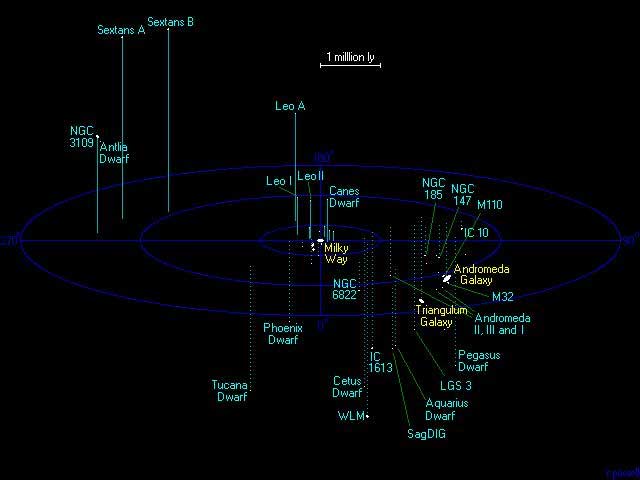- The Local Group of Galaxies, SEDS Messier pages
- A Survey of the Resolved Stellar Content of Nearby Galaxies Currently Forming Stars, Lowell Observatory
- van den Bergh, Sidney (2000). "Updated Information on the Local Group". The Publications of the Astronomical Society of the Pacific 112 (770): 529-536.
The Local Group is the group of galaxies that includes our galaxy, the Milky Way. The group comprises over 35 galaxies, with its gravitational center located somewhere between the Milky Way and the Andromeda Galaxy. The galaxies of the Local Group cover a 10 million light-year diameter (see 1 E22 m for distance comparisons) and have a binary (dumbbell)[1] shape. The group is estimated to have a total mass of (1.29 ± 0.14)×1012M☉.[1] The group itself is one of many within the Virgo Supercluster (i.e. the Local Supercluster).[2] The two most massive members of the group are the Milky Way and the Andromeda Galaxy. These two barred spirals each have a system of satellite galaxies. * The Milky Way's satellite system consists of Sagittarius Dwarf Galaxy, Large Magellanic Cloud, Small Magellanic Cloud, Canis Major Dwarf, Ursa Minor Dwarf, Draco Dwarf, Carina Dwarf, Sextans Dwarf, Sculptor Dwarf, Fornax Dwarf, Leo I, Leo II, and Ursa Major Dwarf. * Andromeda's satellite system comprises M32, M110, NGC 147, NGC 185, And I, And II, And III, And IV, And V, Pegasus dSph, Cassiopeia Dwarf, And VIII, And IX, and And X. The Triangulum Galaxy, the third largest and only ordinary spiral galaxy in the Local Group, may or may not be a companion to the Andromeda galaxy but probably has Pisces Dwarf as a satellite. The other members of the group are gravitationally secluded from these large subgroups: IC1613, Phoenix Dwarf, Leo A, Tucana Dwarf, Cetus Dwarf, Pegasus Dwarf Irregular, WLM, Aquarius Dwarf, and Sagittarius Dwarf Irregular. History Edwin Hubble was the first to identify the Local Group in Chapter VI of his book The Realm of Nebulae (Hubble 1936, pp. 124-151). There he describes it as "a typical small group of nebulae which is isolated in the general field." In that book, he delineated by decreasing luminosity its members to be M31, the Milky Way, M33, the Large Magellanic Cloud, the Small Magellanic Cloud, M32, NGC 205, NGC 6822, NGC 185, IC 1613 and NGC 147. He also identified IC 10 as a possible Local Group member. In the ~70 years since his work, the number of known Local Group members has increased from his initial 12 to 36 in 2003. This was by way of almost two dozen low-luminosity galaxies.[3] Component galaxies Map
Map of the Local Group of Galaxies (*) Galactic bodies
Other notable objects * Smith's Cloud - High velocity cloud, 8000 light-years from Earth * HVC 127-41-330 - High velocity cloud, 2.3 million light-years from Earth Links References
Retrieved from "http://en.wikipedia.org/"
|
|
|||||||||||||||||||||||||||||||||||||||||||||||||||||||||||||||||||||||||||||||||||||||||||||||||||||||||||||||||||||||||||||||||||||||||||||||||||||||||||||||||||||||||||||||||||||||||||||||||||||||||||||||||||||||||||||||||||||||||||||||||||||||||||||||||||||||||||||||||||||||||||||||||||||||||||||||||||||||||||
